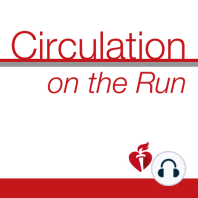18 min listen
Circulation August 31, 2021 Issue
ratings:
Length:
27 minutes
Released:
Sep 1, 2021
Format:
Podcast episode
Description
This week's episode features special Guest Host Mercedes Carnethon, as she interviews author Kypros Nicolaides and Associate Editor Karol Watson as they discuss the article "Pravastatin versus Placebo in Pregnancies at High Risk of Term Preeclampsia." Dr. Carolyn Lam: Welcome to Circulation on the Run, your weekly podcast summary and backstage pass to the journal and its editors. We are your co-hosts, I'm Dr. Carolyn Lam associate editor from the National Heart Center and Duke National University of Singapore. Dr. Greg Hundley: And I'm Dr. Greg Hundley associate editor, director of the Pauley Heart Center, VCU Health in Richmond, Virginia. Dr. Carolyn Lam: We have a really important feature discussion today. It's on pravastatin versus placebo in pregnancies at high risk of term preeclampsia. Very important condition. And I'm just so glad that we will be discussing this issue, coming right up. But first, I want to start on the other papers in this issue. And this first study, which is the first study to assess the effects of aerobic exercise training with and without caloric restriction on changes in the proximal aortic stiffness using cardiovascular magnetic resonance imaging. Now the corresponding author is Dr. Brinkley from the Sticht Center of Healthy Aging and Alzheimer's Prevention in Wake Forest School of Medicine. But guess what? Our very own Dr. Greg Huntley is a co-author. So whether you know it or not, Greg, we're going to do a mini feature, right now. So Dr. Huntley, could you please give us some background to your study, it's so cool? Dr. Greg Hundley: Oh, Carolyn, thank you so much. It's quite a privilege to be, actually being interviewed by you. So about the paper. Aortic stiffness is really a prominent manifestation, as we know, of vascular aging. And it's an independent predictor of cardiovascular events and mortality. And risk factors such as hypertension, diabetes, obesity, they can promote vascular changes that lead to accelerated vascular aging. Now, on the other hand, lifestyle factors such as healthy diet, regular physical activity, they may attenuate age related increases and aortic stiffness. Dr. Greg Hundley: And both cross-sectional and longitudinal studies indicate that exercise is associated with lower aortic stiffness. However, some data suggests exercise alone may not be sufficient to improve aortic stiffness in certain subpopulations of older adults. And so what Tina did, she worked in combination with all the co-authors and determined the effects of aerobic exercise training, with and without moderate to high caloric restriction on the structure and function of the proximal aorta in a 160 older, so 65 to 79 year old men and women with obesity that had a body mass index of 30 to 45 kilograms per meter square. Dr. Carolyn Lam: Wow. Okay, cool. But how do you assess this by MRI? Isn't that part of the novelty of the study, right? Dr. Greg Hundley: Right, Carolyn. So kind of two ways magnetic resonance imaging assesses aortic stiffness. First is to look at the distensibility. What is this distensibility? That's the change in the area of the aorta, relative to the distending pressure. And you can't measure that distending pressure noninvasively. So what we do is use a surrogate, your cuff pressure at your brachial artery. So that's one measure. Area change divided by basically the pulse pressure indexed for the resting area. And the second is pulse wave velocity. And for the listeners, remember pulse wave velocity, the faster the blood moves around through the aorta, the stiffer the artery is. And so we measured both aortic distensibility and pulse wave velocity. Dr. Carolyn Lam: I love it. You're such a good decentral educator. Okay. So what are the results real quick? Dr. Greg Hundley: Thanks Carolyn. So there were significant treatment effects for descending aortic distensibility and strain. And aortic arch pulse wave velocity with the aerobic exercise training plus the moderate caloric restrictio
Released:
Sep 1, 2021
Format:
Podcast episode
Titles in the series (100)
Circulation March 21, 2017 Issue: Circulation Weekly: Your Weekly Summary & Backstage Pass To The Journal by Circulation on the Run
